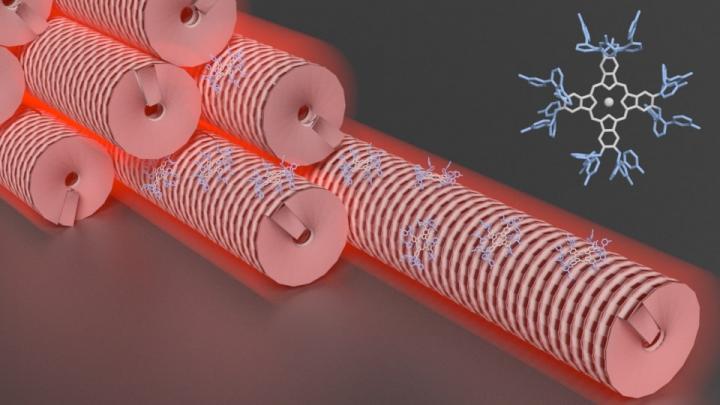Dyes and viruses create new composite material for photooxidation reactions

Schematic representation of the photoactive rod-like virus bundles glued together by action of the dye (top-right corner). Credit: Eduardo Anaya
'Our first challenge was to select the right photosensitizer,' says Eduardo Anaya, Postdoctoral Researcher at Aalto University, 'We decided to employ phthalocyanines, a synthetic derivative of hematoporphyrin (the dye responsible for the colour of blood), due to their outstanding properties as a reactive oxygen species generator. However, the use of this kind of dyes in aqueous media presents several challenges that affect their performance. Therefore, careful design was necessary to maintain their properties`.
In collaboration with Professor Tomas Torres' research group from the Universidad Autonoma de Madrid, a new phthalocyanine derivative was synthesised, resulting in a molecule with resilient properties in different ionic strength media. The design ensured the photoactivity of the dye even in an aqueous environment.
'One of the focuses of our research group lies in the design of new protein assemblies and their potential application as new materials' adds Professor Mauri Kostiainen, leader of the Biohybrid Materials group.
'Our approach is based on supramolecular interactions, such as electrostatic binding so, in this project, we decided to combine the positively charged dye with a negatively charged tobacco mosaic virus (a 300 nm long rod-like virus), resulting in a photoactive fibrous material.
This approach led to highly ordered threads, which were thoroughly characterised by X-ray scattering and several microscopy techniques in the Nanomicroscopy Center at Aalto', Kostiainen says.
In addition to the structural characterisation, Anaya points out that the most crucial feature is that the dye remains active despite being immobilised in the fibres.
´We can fix the reaction site in solid support and pass the solution we want to react through it, being visible light the only “fuel” we use for it to happen. This allows us to create a continuous flow set-up that enable the scaling up of the oxidation process', he concludes.
The research team designed a proof-of-concept device where immobilising the fibres within a glass capillary; an incoming flow was oxidised in several cycles. The resilience of the fibres was assessed, concluding that both their structural stability and photoactivity remain constant over time.
One additional advantage is that, once the oxidation process is completed, a light pulse can disassemble the fibres, making them easy to dispose of. The reported approach represents the first step towards the use of biohybrids in continuous flow reactions, which represent an environmentally friendly approach to this type of industrial process.
###
The results were published in Advanced Materials, 08 August 2019.
Media Contact
All latest news from the category: Materials Sciences
Materials management deals with the research, development, manufacturing and processing of raw and industrial materials. Key aspects here are biological and medical issues, which play an increasingly important role in this field.
innovations-report offers in-depth articles related to the development and application of materials and the structure and properties of new materials.
Newest articles

NASA: Mystery of life’s handedness deepens
The mystery of why life uses molecules with specific orientations has deepened with a NASA-funded discovery that RNA — a key molecule thought to have potentially held the instructions for…

What are the effects of historic lithium mining on water quality?
Study reveals low levels of common contaminants but high levels of other elements in waters associated with an abandoned lithium mine. Lithium ore and mining waste from a historic lithium…

Quantum-inspired design boosts efficiency of heat-to-electricity conversion
Rice engineers take unconventional route to improving thermophotovoltaic systems. Researchers at Rice University have found a new way to improve a key element of thermophotovoltaic (TPV) systems, which convert heat…



